
Chaenactis xantiana, the Mojave pincushion or Xantus pincushion, is a flowering plant in the family Asteraceae, native to the western United States, from southeastern Oregon, Nevada, southern and eastern California and northwestern Arizona. It is very common in the Antelope Valley in the Mojave Desert, and grows in sandy soils.
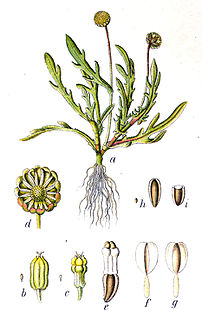
The small marsh flower Cotula coronopifolia bears the common names brass buttons, golden buttons, and buttonweed. The flower heads are bright yellow discoid heads that look like thick buttons. Individual plants spread stems along the ground and send up the knobby flowers at intervals. The plant is native to southern Africa, as well as New Zealand, but it has been introduced to other parts of the world.
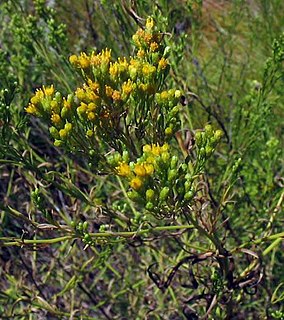
Euthamia occidentalis is a flowering plant, known by the common names western flat topped goldenrod, western goldentop and western goldenrod, in the family Asteraceae.
Coreopsis stillmanii is a species of flowering plant in the daisy family known by the common name Stillman's tickseed. It is endemic to California, where it grows in the Central Valley and most of the adjacent coastal and inland mountain ranges in California chaparral and woodlands habitats. It is found east of San Francisco Bay and on the eastern side of the Central Valley.
Lycium californicum is a spreading shrub in the nightshade family known by the common names California boxthorn and California desert-thorn.

Chaenactis fremontii, with the common names Frémont's pincushion and desert pincushion, is a species of annual wildflower in the daisy family. Both the latter common name, and the specific epithet are chosen in honor of John C. Frémont.
Eriophyllum multicaule is a North American flowering plant in the daisy family, known by the common name manystem woolly sunflower. It is native to California and Arizona in the southwestern United States.

Helianthus cusickii is a species of sunflower known by the common names Cusick's sunflower and turniproot sunflower. It is native to the western United States from Washington, Oregon, Idaho, northern California, and northwestern Nevada.

Heliotropium curassavicum, commonly called salt heliotrope, a species of flowering plant in the borage family (Boraginaceae). It is native to much of the Americas, from Canada to Argentina, including the West Indies and Hawaii. It can be found as an introduced, and sometimes invasive, species in Africa, Asia, Australia, and Europe. It thrives in salty soils, such as beach sand, alkali flats, and salt marshes. It is often found in disturbed coastal sites.

Isocoma acradenia is a North American species of flowering plant in the daisy family known by the common name alkali goldenbush.
Isocoma arguta is a rare species of flowering plant in the daisy family known by the common name Carquinez goldenbush. It has been found only in Solano and Contra Costa Counties in California, where it grows in the Sacramento-San Joaquin River Delta. It is a resident of Suisun Marsh. It thrives on alkali flats and other mineral-rich soils.
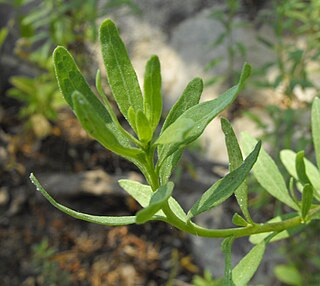
Iva hayesiana is a species of flowering plant in the daisy family known by the common names San Diego marsh-elder and San Diego povertyweed.
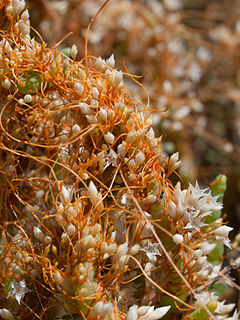
Cuscuta salina is a species of dodder known by the English name salt marsh dodder and is a native plant of western North America. The habitat includes coastal tidal wetlands in California, as well as saline habitats away from the coast, such as vernal pools and salt flats. Salt Marsh Dodder is a parasitic plant, wrapping orange-colored stems around natural wetland vegetation and absorbing nutrients of host plants via their specialized structures called haustoria.

Almutaster is a North American genus of plants in the aster family containing the single species Almutaster pauciflorus, which is known by the common name alkali marsh aster. It is native to Canada (Northwest Territories and the 3 Prairie Provinces, the Western United States, and northern and central Mexico.

Atriplex watsonii is a species of saltbush known by the common name Watson's saltbush, or Watson's orach. It is native to the coastline of California and Baja California, where it grows in coastal areas with saline soils, such as salt marshes and beach scrub, with other halophytes such as saltgrass. It extends inland in the Los Angeles Basin, and along the Santa Ana River.
Chaenactis alpigena is a species of flowering plant in the daisy family known by the common name southern Sierra pincushion. It is native to the High Sierra Nevada and the White Mountains of California, extending in the latter just into Nevada.

Chaenactis glabriuscula, with the common name Yellow pincushion, is a species of flowering plant in the daisy family. It is native to California and Baja California.
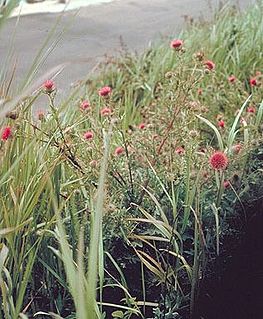
Cirsium andrewsii is an uncommon species of thistle known by the common name Franciscan thistle. It is endemic to California, where it is known from the coastline of the San Francisco Bay Area from Marin to San Mateo Counties. There are also reports of isolated populations in the Klamath Mountains and in the Sierra Nevada.

Cirsium hydrophilum is a species of thistle which is endemic to California, where it is found only in the San Francisco Bay Area and the Sacramento-San Joaquin River Delta. This native thistle grows in wet boggy habitats.

Senecio hydrophiloides is a species of flowering plant in the aster family known by the common names tall groundsel and sweet marsh ragwort. It is native to western North America from British Columbia and Alberta to northern California to Utah, where it grows in wet meadows and similar habitat. It is a biennial or perennial herb producing a single erect stem or a cluster of a few stems which may exceed one meter in maximum height. The plants are green to red in color and usually without hairs, but new growth can be woolly. The leaves are lance-shaped to oval with toothed edges, the blades up to 25 centimeters long and borne on long winged petioles. The leaves are firm and sometimes a bit fleshy. The inflorescence is a loose or dense cluster of up to 30 or more flower heads lined with black-tipped phyllaries. They contain many yellowish disc florets at the center and often have some yellow ray florets, though these are sometimes absent. Senecio Hydrophiloides can cause Dermatitis.















